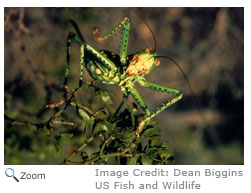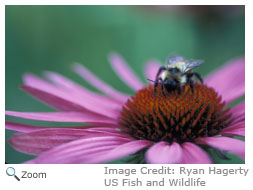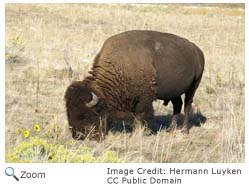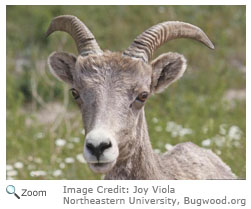Just Plants, Please
 Animals that eat only plants are called herbivores. Deer, grasshoppers, and rabbits are all herbivores. There are lots of different plants
and lots of different herbivores. Some herbivores eat only part of a plant. Animals that eat only plants are called herbivores. Deer, grasshoppers, and rabbits are all herbivores. There are lots of different plants
and lots of different herbivores. Some herbivores eat only part of a plant.
What's the Buzz?
 Bees take nectar from flowers for energy. When bees gather nectar, they pick up pollen on their fuzzy bodies. As bees travel from flower to flower gathering nectar, they leave some pollen behind. Pollen left behind pollinates flowers and helps these plants reproduce. Bees have a symbiotic relationship with the flowers they pollinate. A symbiotic relationship is one that benefits both living things; for example, bees get the nectar they need and the flowers get pollinated! Bees take nectar from flowers for energy. When bees gather nectar, they pick up pollen on their fuzzy bodies. As bees travel from flower to flower gathering nectar, they leave some pollen behind. Pollen left behind pollinates flowers and helps these plants reproduce. Bees have a symbiotic relationship with the flowers they pollinate. A symbiotic relationship is one that benefits both living things; for example, bees get the nectar they need and the flowers get pollinated! |
|
Time to Munch
 Plants are often very easy for herbivores to find, but they are sometimes low in the nutrients the animals need to grow and stay healthy. Seeds are often packed with energy-rich nutrients like starches, but other parts of plants -- like stems and leaves -- don't have as many nutrients. Herbivores that rely on those plant parts must spend a lot of their time grazing and browsing to get the nutrients they need! Plants are often very easy for herbivores to find, but they are sometimes low in the nutrients the animals need to grow and stay healthy. Seeds are often packed with energy-rich nutrients like starches, but other parts of plants -- like stems and leaves -- don't have as many nutrients. Herbivores that rely on those plant parts must spend a lot of their time grazing and browsing to get the nutrients they need!
Chewing It Over
 Some herbivores have digestive systems to help them get the most out of the plants they eat. Animals like sheep, moose, white-tailed deer, and cows have a special stomach called a rumen where microorganisms break down cellulose. Animals with a rumen are called ruminants. Ruminants swallow their food and then regurgitate it and chew on it again to break down the cellulose in the plant. Once the cellulose is broken down, the food returns to the stomach where it is digested. When you hear that an animal is chewing its cud, it is re-chewing food that it had already swallowed! Some herbivores have digestive systems to help them get the most out of the plants they eat. Animals like sheep, moose, white-tailed deer, and cows have a special stomach called a rumen where microorganisms break down cellulose. Animals with a rumen are called ruminants. Ruminants swallow their food and then regurgitate it and chew on it again to break down the cellulose in the plant. Once the cellulose is broken down, the food returns to the stomach where it is digested. When you hear that an animal is chewing its cud, it is re-chewing food that it had already swallowed!
|